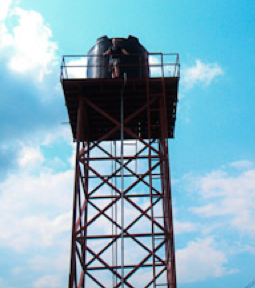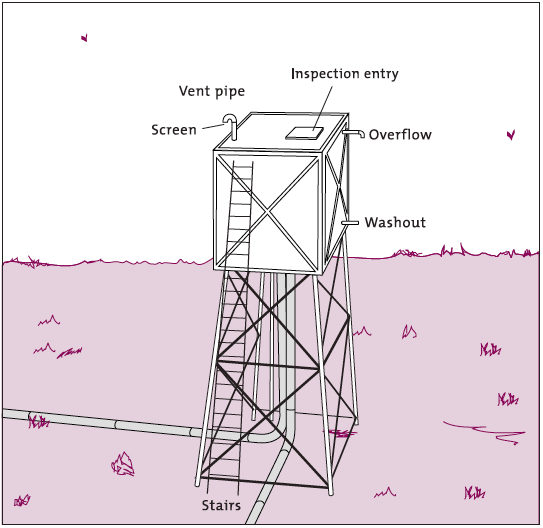Elevated steel reservoir

An elevated steel reservoir stores clean water in a steel tank on a raised stand or tower. The elevation of the tank provides the water pressure to all points in the pressure zone of the distribution system. Tanks may be cylindrical, rectangular or any other convenient shape. For family use, the tank can be made of an old oil drum (duly coated), and the tower of bamboo. For communal needs, elevated steel tanks are often constructed from factory-made galvanized steel elements bolted or welded together. However, even with galvanization, steel tanks are generally more sensitive to corrosion than concrete reservoirs. On the other hand, steel tanks can be built faster and the cost of transporting the material is generally lower, especially when concrete aggregates are not locally produced.
Several pipes are connected to the tank, including ones for inlet, outlet, overflow and washout, and a screened vent hole or pipe maintains atmospheric pressure in the tank. There is also an entryway in the cover of the reservoir to allow the reservoir to be inspected. The entryway is normally kept closed with a lid. If an electric pump is used to pump water into the reservoir, the water level in the reservoir can be regulated by sensor electrodes in the tank. Alternatively, a float valve may be used to cut off the inflow when the maximum level has been reached.
The tanks may be placed on steel, wooden or reinforced-concrete towers, and special attention must be given to the foundation structure. Big elevated steel tanks are typically used by major water users, such as agricultural enterprises and communities.
Construction, operations and maintenance
Operation consists of opening and closing the valves, and managing a chlorinator if one is used. This is usually done by a caretaker who lives nearby.
For maintenance, the valves must be opened and closed every two months to prevent them from sticking. Some valves need lubricating. The screens must also be checked, and occasionally a screen or valve may need to be repaired. The inside of the reservoir should be cleaned at least every six months and disinfected using a chlorine solution. The tank and the stand should be painted once a year – epoxy-paint coatings should need little maintenance. Any leaks should be repaired immediately.
Potential problems
— the reservoir may become corroded and leak;
— steel reservoirs normally require cathodic protection (erosion control);
— steel reservoirs need relatively more maintenance than those made of concrete, ferrocement or even wood.
Costs
Initial cost: Prices vary considerably between countries and tank quality. In 1991, in Tanzania, a circular above-ground tank made of galvanized iron cost US$ 125 for a 1 m3 tank (US$ 125 per m3) and US$ 550 for a 10 m3 tank (US$ 55 per m3).
Field experiences
A water tank in Kenya was built in combination with a borehole as the source. If fresh water is found in sufficient quantities and the water is not saline, the borehole is cased with a special piping.
A recent report for the Ministry of Water by PEM Consultants states that only 60 drilled boreholes are successful. Although Boreholes Contractors cannot guarantee anything, they must be paid in full for their drilling. The borehole seen in the photo (on the right) is 104 metres deep and supplies 20,000 litres of fresh water in an hour, which is sold for Ksh 3 per 20 litres, which is Ksh 3,000 (US$ 35) per hour. A successful borehole as this one costs about Ksh 3 million (US$ 35,000), inclusive of casing, pump, elevated tank and pump house.
As a water business, it can be estimated that if recharge can allow pumping for 5 hours daily and the daily operation cost is Ksh 5,000 (US$ 60), the actual income will be Ksh 10,000 (US$ 120) per day. With a loan of Ksh 3 million with 20% interest and fees, it will take 380 working days (3,000,000 + operation 200,000 + interest costs 600,000 / 10,000/day = 380) to recover the investment. Thereafter it is daily profit.
Manuals, videos, and links
- Water tank. Wikipedia.
- Elevated water tanks, in India includes costs.
- Plastic commercial rainwater tanks: Rainwater Tanks Direct. Australia.
Acknowledgements
- Brikke, François, and Bredero, Maarten. Linking technology choice with operation and maintenance in the context of community water supply and sanitation: A reference document for planners and project staff or (alternative link). World Health Organization and IRC Water and Sanitation Centre. Geneva, Switzerland 2003.
- Water as a business. Infonet-biovision.


